
May is Water Safety Month and is a perfect time to learn how to keep yourself and others safe as you get ready for a summer full of water-related fun. The U.S. government has a plethora of messengers—human, animal, and inanimate—ready to give you advice on how to stay safe in the water. These characters have been developed over many decades and may be incarnated as drawings, animated cartoons, humans in costume, or even as puppets!
Note that occasionally some of the advice promulgated here may have become debunked by more recent research findings. For example, several of these messengers advise against swimming right after eating. Following this rule is not dangerous, but it is also not necessary according to the latest data.
U.S. Army Corps of Engineers
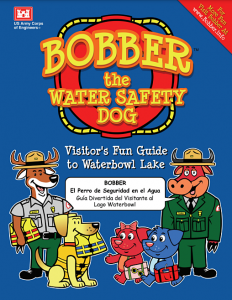
Bobber the Water Safety Dog: Visitor’s Fun Guide to Waterbowl Lake
This 28-page coloring and activity book teaches water safety lessons to children through the adventures of U.S. Army Corps of Engineers spokesdog Bobber and his canine companions at Waterbowl Lake:
- Corky and Sinker (dogpaddling girl and boy pups—guess which one wears her lifejacket?),
- Tackle (a retired mascot for the Big City Bulldogs who loves to fish—for catfish, of course),
- The hot-headed Hot Dog and his pal Chili Dog, who is perpetually shivering from fright or hypothermia.
- Ranger Buck provides guidance and advice in English while Ranger Toro repeats everything in Spanish. (Speakers of Spanish constitute a major segment of visitors to recreational sites, but it is a challenge to accommodate the variety of dialects so that information is accessible to everyone.)
- Buddy Beaver, Seamoor Safety the sea serpent, and Ranger Jane Doe complete the cast to provide further advice and adventure.
If you’re interested in pursuing more adventures with Bobber and his buddies, the official Bobber web site at www.bobber.info provides access not only to the 28-page Bobber fun book, but also to supplementary coloring sheets and activities, as well as four cartoons in English and Spanish (narrated by Don Harris from the USACE Fort Worth District). All these charming cartoon characters were drawn by Toby Isbell, a visual information specialist in the USACE Little Rock District, using Adobe Illustrator and the now-obsolete Adobe Flash to create the simple animated cartoons.
You can join in the fun by submitting your personal fan art or water safety photos. Download and cut out your own “Take Along Bobber” to create a selfie posing with Bobber on your next trip to the lake, but be sure to wear your life jacket!
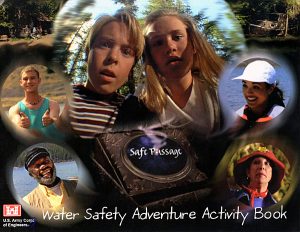
Safe Passage: Water Safety Adventure Activity Book
Safe Passage is a complete water-safety curriculum developed by the U.S. Army Corps of Engineers and centered around a 36-minute video called Safe Passage that tells a story about two young people who go on an adventure in which they meet four mysterious messengers who initiate them in the ways of water safety and provide them with magical compasses to guide them home:
- Topher teaches them the principles of safe swimming;
- Wanda teaches them how to avoid danger around hydroelectric dams, rivers, and canals;
- Scully teaches them how to stay safe on boats and other watercraft; and
- Sam teaches them how to rescue someone from drowning.
In addition to the video and activity book, there are a series of lesson plans and activities for students in various levels of elementary school:
- K–2nd Grade Safe Passage Activities
- 3rd–4th Grade Safe Passage Activities
- 5th–6th Grade Safe Passage Activities
By coloring the pictures and working through the activities in the Safe Passage Water Safety Adventure Activity Book, you will meet these four messengers yourself and become the protagonist of this story, eventually earning your Certificate of Safe Passage and the right to call yourself a “Master Water Riddle Solver.” The lessons of your magical messengers are conveniently summarized on a set of four bookmarks you can cut out and keep.
The Safe Passage Water Safety Adventure Activity Sheet provides a succinct, two-page summary of the activity book. (Sadly, two pages did not leave enough room to include the larger-than-life Wanda.)
Other USACE Messengers
The U.S. Army Corps of Engineers National Water Safety Program has developed many campaigns featuring water safety spokescharacters over the years, usually by looking at annual statistics, identifying a target audience, and figuring out what issues need to be focused on. Often a campaign or project idea will originate with a local USACE district and prove so popular that the materials are selected for national distribution.
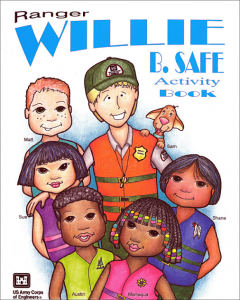
Ranger Willie B. Safe Activity Book
Willie B. Safe was accident-prone around the lake as a child, but he learned his lessons well and grew up to be a USACE Park Ranger who “represents the spirit of safety all rangers carry,” “teaching all the kids what safety means.” His story is told in folksy rhymed couplets, illustrated with line drawings by Kathy Dickson and accompanied by numerous games and activities. This character originated at Wappappelo Lake in the USACE St. Louis district, where Ranger Willie B. Safe would talk about water safety issues with groups of visitors at the lake. This water safety messenger proved so popular that he was eventually incorporated into the National Water Safety Program.

In this coloring and activity book a beaver and a duck, both wearing lifejackets, provide rules on water safety, plus a few rules about taking care of nature. No names are provided for these two water-safety messengers. The duck also wears a very wide-brimmed boater hat. Water Safety Fun Book in Spanish translation is also available.
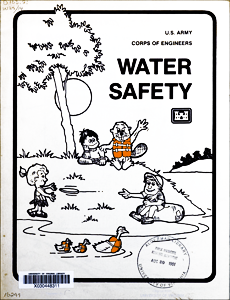
The cover of this water safety coloring and activity book from the U.S. Corps of Engineers features a beaver and a family of ducks, all wearing orange life jackets that stand out because they are the only color in this black and white line drawing. Inside the beaver uses standard coloring book games and activities such as a a word search, crossword puzzles, a jigsaw puzzle, connect-the-dots, a maze, and object identification games to reinforce basic concepts of water safety and rescue. We finally learn the name of Bobby Beaver on the very last page (where he appears once again in an orange vest), but the ducks never even make an appearance between the covers of this book! It is not clear whether Bobby Beaver has any connection to Buddy Beaver, mentioned above.
U.S. Department of the Interior, Bureau of Reclamation
Created by a fourth grade student in response to a contest, Otto Otter has been the U.S. Bureau of Reclamation’s official water safety messenger since 1975. The primary purpose of the Otto Otter Canal Safety Program is to educate the public (especially children) about the dangers of canals and to emphasize the importance of staying out and staying away. This character always appears in an old-timey men’s bathing costume featuring horizontal stripes of red, white, and blue, with a row of white stars around the lowest stripe. He also wears a badge with his name on it.
Otto Otter for Safe Water is a 16-page coloring book for young children that provides water safety advice in a series of (mostly) rhyming couplets. Each line begins with the punning phrase “You OTTER. . .” (i.e., “You Oughta). Although this book does mention the dangers of swimming in canals, it also provides more general advice. The artist who created the hand-drawn illustrations is not identified.
Supplementary coloring pages are available at Otto Otter Coloring Page #1 and Otto Otter Coloring Page #2. These two elaborate but wordless images are suitable for hanging on the wall as posters.
The Otto Otter for Canal Safety coloring book doesn’t have as snappy a title as the earlier coloring book, but it provides much more detailed advice on the dangers of swimming in canals. Each page contains a rule introduced by the phrase “OTTO OTTER says:” and the advice is repeated in Spanish on the same page. There are no rhymes in this 2013 publication, and the polished illustrations appear to have been made with a vector graphics editor such as Adobe Illustrator. A maze and a connect-the-dots puzzle add some opportunity for interaction besides coloring.
Some public service announcements featuring Otto Otter and friends (the coincidentally-named Governor C.L. “Butch” Otter and First Lady Lori Otter of Idaho) are available for viewing on YouTube:
- Canals Aren’t for Fooling Around!
- Leash Up, Stay Out, Stay Alive!
- Stay Out and Stay Alive!
- Canal Safety with Two Otters
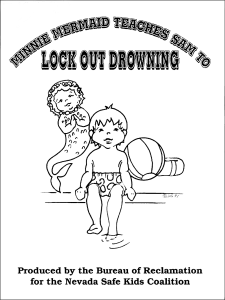
Minnie Mermaid Teaches Sam to Lock Out Drowning
This coloring book for very young readers features Minnie Mermaid, who teaches a little boy ten commandments for staying safe in and around water. Curiously, Minnie Mermaid is almost never seen swimming in the water—except for one moment when her caudal fin can be glimpsed breaking the surface, she only floats wraithlike in the air. Is she a ghost? The text appears as short sentences in large print, much like what one would find in a basal reader. Supplemental information is provided for parents on the back cover. The illustrator is identified only as “JG” in the copyright notices that appear on each page.
This unique, rather surreal pamphlet issued by the Bureau of Reclamation features a water safety messenger named “SAF-T” who looks like a safety pin with a human face, hair, and limbs. There is also a silent, unnamed rat that occasionally appears on the periphery, somewhat like the “dingbats” of political cartoonists such as Pat Oliphant (Punk the Penguin) or Fred O. Seibel (Moses the Crow).
Basic principles of water safety are summarized in the Water Safety Pledge: seven “Do’s” and five “Don’ts” presented as a two-page spread that can be displayed as a poster by removing the staples from the pamphlet and separating the pages.
Everything is illustrated throughout in by the whimsical cartoons of David Cunningham, an illustrator employed by Bureau of Reclamation Region 7 who signed his name as “CunningHAM.” You can see more of his illustrations in John T. Maletic’s article “Weed Warning,” which appeared in the Bureau of Reclamation publication Reclamation Era in 1955.
U.S. Consumer Product Safety Commission

Splish and Splash are a cat and dog who save lives by encouraging safe behavior around pools and hot tubs. They were created by the U.S. Consumer Product Safety Commission as part of their public education campaign Pool Safely: Simple Steps to Save Lives.
The Adventures of Splish & Splash is a set of animated cartoons depicting the characters Splish and Splash in a variety of situations that take place in and around swimming pools and hot tubs. Each cartoon is followed by a single multiple-choice question. The Flash technology is outdated, but you can check out a DVD from Sycamore Library to play these games if you have a set-up that can play Flash.
Alternatively, you can download a smartphone app from the iTunes App Store or from Google Play to play a set of interactive games that are advertised as a “brand-new version” of The Adventures of Splish & Splash. These are completely different games from those on the DVD. Instead of allowing the action to be watched passively on a computer screen, these games require the player to tilt a smartphone or iPad and touch the screen to direct the actions of the characters. These simple but challenging activities teach your child how to design a safe and fun pool, avoid drains, stay within sight of an adult “Water Watcher,” and enter the pool only with an adult present. This is the first app launched by the Consumer Product Safety Commission.
U.S. Department of the Army
The U.S. Armed Services have frequently employed anthropomorphic mascots and messengers in their training materials to make technical subjects more comprehensible to servicemen who come to their military career from diverse—often rural—backgrounds and may find humorous visual presentations and stories easier to remember than dense, dry text.
This U.S. Department of the Army pamphlet is one of the few water safety instruction booklets created primarily for adults rather than children or teenagers. It uses an anonymous, anthropomorphic fish (somewhat resembling the protagonist of the 1964 Disney film The Incredible Mr. Limpet) to teach soldiers how to stay safe while swimming and diving, with special emphasis placed on learning how to swim, following common sense rules about swimming only in approved areas, checking the water before diving in, and making sure someone is watching the children at all times; but also being alert to less well-known dangers such as the risks of swimming or diving in cold water, which is a major cause of drowning deaths in the Army. (Oddly, this piscine messenger, who is equally comfortable in or out of the water, seems completely unconcerned about the dangers of being fished. At one point they even describe fishing as “fun”!) Finally, advice is dispensed on how to rescue yourself or someone else in an emergency.
Would You Like to Know More?
Find out more about the amazing mascots and messengers of the U.S. government at our blog post entitled “Meet the Amazing Mascots and Messengers of the U.S. Government.”
Visit Sycamore Library on the University of North Texas Campus to explore the many resources in our Government Documents Collection. Sycamore Library is also host to the UNT Libraries Juvenile and Curriculum Materials Collections.
If you need assistance with finding or using government information resources, please visit the Service Desk in the Sycamore Library during regular hours, contact us by phone (940) 565-4745, or send a request online to govinfo@unt.edu.
If you need extensive, in-depth assistance, we recommend that you E-mail us or call the Sycamore Service Desk at (940) 565-2870 to make an appointment with a member of the Sycamore Library Staff.
Resources
Berge, Paul. “Meet the Dingbats.” Berge’s Cartoon Blog. February 18, 2023.
Levenson, Jess. “Bobber the Water Safety Dog Returns.” U.S. Army Corps of Engineers, New England District. October 5, 2017. Reposted on Defense Visual Technical Information Service. February 26, 2018.
Harvey, R.C. “Rabbits Galore.” The Comics Journal Blog. April 5, 2010. Reprinted at RCHarvey.com: http://rcharvey.com/bio.html
Maletic, John T. “Weed Warning.” Reclamation Era 41, No. 1 (February 1955): 13–15.
“Otto Otter Canal Safety Program.” Bureau of Reclamation. Last updated January 16, 2025.
Seals, Dorothy. “Cartoon Carries Water Safety Message.” Engineer Update 27, No. 6 (June 2003): 3.
Tate, Bernard. “Corps of Engineers National Water Safety Program Thriving, Saving Lives.” Engineer Update 29, No. 8 (August 2005): 4–5.
U.S. Army Corps of Engineers. Student Conservation Association Public Safety Intern Handbook. May 2010.
“Water Safety Summit Is Rewarding Experience.” Pacesetter 3, No. 3 (June 2008): 19.
Article by Bobby Griffith.


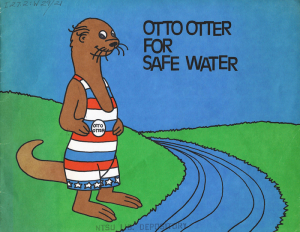
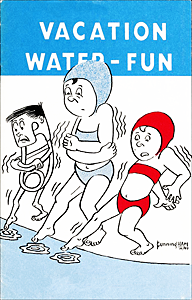

Leave a Reply